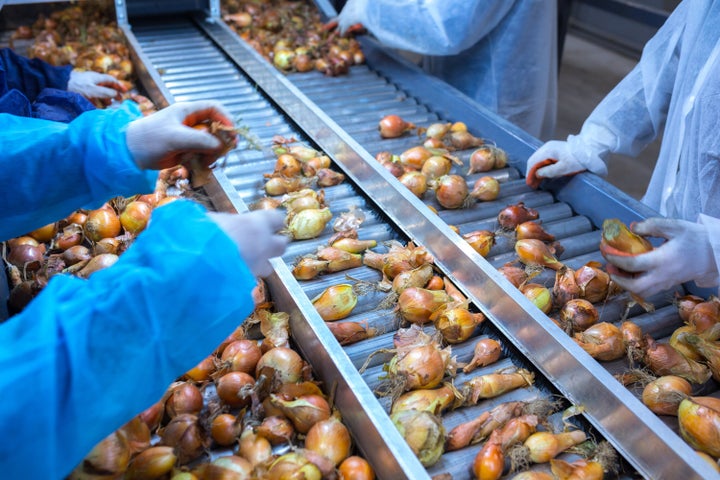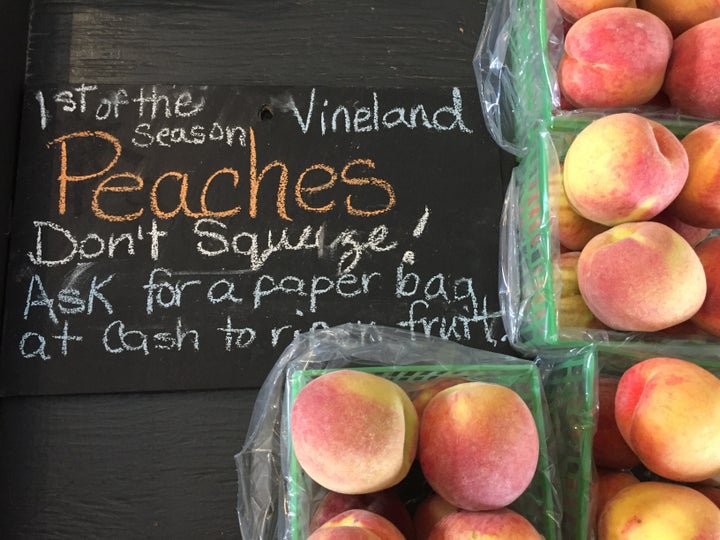As if a coronavirus pandemic weren’t enough, more than 1,000 people in 47 states got infected with salmonella in July from onions grown in California and sent to distributors, wholesale suppliers and stores across the country. Then along with the delight that is summer peach season came another salmonella outbreak, which made 78 people in 12 states sick in August.
Both instances of contamination triggered nationwide recalls (peaches were also recalled in Canada, Singapore and New Zealand). The U.S. Food and Drug Administration cautioned consumers to throw away any onions or peaches of unknown provenance or any that may have comingled with tainted produce in the supermarket bin. For most shoppers, given how little information we have on where our food comes from, that could translate to: Toss out all your onions and your peaches, too.
“It is certain that the contaminated peaches were distributed widely through large retail chains and under a variety of brands and in bulk. This makes it more difficult for the consumers to quickly understand what products to look out for,” said Sanja Ilic, an Ohio State University associate professor and food safety state specialist.
When produce is shipped all around the country, any dangerous bacteria it harbors can sicken people who live hundreds or thousands of miles from where it was grown. While sticking to stringent safety standards is the best way to prevent foodborne illness, Ilic told HuffPost, eating more locally produced food could keep outbreaks from spreading far and wide.
Some 48 million Americans get sick every year by eating contaminated foods, according to estimates from the Centers for Disease Control and Prevention. Salmonella is one of the most common culprits, causing more than 30 multistate outbreaks in the last five years through a variety of foods from cucumbers and melons to frozen tuna and ground beef.
“The risk starts at farm level where produce can be contaminated via contaminated water, animal waste, human handling, or cross-contaminated from dirty surfaces,” Ilic explained. But “contamination can occur at any point” — from processing and packing plants to distribution centers to restaurants and store shelves.

“When you look at major outbreaks like this ― for example, the romaine lettuce [E. coli] outbreak from last year ― there are just so many hands on that produce,” said Liz Vallette, president of the Houston urban farming nonprofit Plant It Forward Farms. By contrast, she said, “For local farms like ours, there’s no commercial packing facility, very few hands on our produce, and ultimately fewer touchpoints that could lead to such an outbreak.”
Plant It Forward trains refugees to grow vegetables in urban settings and sells that produce to restaurants and at farmers markets around Houston.
“We’re so hyperlocal that customers are often purchasing food that’s harvested that same day,” said Vallette. “And because the food isn’t being stored or transported for a long period of time, it’s not being sprayed with anything to preserve it.”
Locally grown food is in no way immune to bacterial contamination, but with its shorter supply chain and regionally restricted distribution, illness outbreaks are naturally more contained and easier to track.
“Buying local could potentially provide some level of control to the consumer, especially if they buy from a known grower,” said Ilic. But doing so, she added, is not always as straightforward as it sounds.
For one thing, “local food” is a very loosely defined term. It can refer to produce grown within 50 miles or as far as 275 or 400 miles away.
Consumer demand for year-round produce introduces another layer of complication. “Oftentimes, growers (even local) would buy from other sources to ensure consistent supply,” Ilic said.
And moving away from our nationally scaled food system would be a monumental task, she cautioned. “Buying local exclusively would require a major shift in how the produce is marketed and distributed,” Ilic noted.
Agriculture in this country is a highly centralized business, dominated by large industrial companies and supermarket chains. Consumers are accustomed to low prices and convenience. At last count, fewer than 10% of U.S. farms sell their products locally to customers.

Yet when it’s possible to do so, buying from local farms — typically those that are small and medium-sized — has advantages that go well beyond containing outbreaks. One widely cited study from 2001 estimated that national distribution of produce emits five to 17 times more carbon dioxide than when produce is sold regionally, at farmers markets, directly to consumers through farm shares, or at local stores and restaurants.
Small farms are more likely than industrial operations to engage in sustainable practices such as organic farming or regenerative agriculture, which focuses on maintaining soil health and biodiversity to promote healthy ecosystems and mitigate climate change. That’s better for the environment and people’s health ― particularly when it comes to rethinking livestock farming, a major emitter of greenhouse gases.
Factory farming and a growing demand for animal protein are two of the main drivers of zoonotic disease — illnesses transmitted from animals to humans, such as the swine flu and bird flu ― according to a new United Nations report. (Our current zoonotic outbreak, the COVID-19 pandemic, is not associated with farming specifically.)
But foods grown using sustainable methods tend to be more expensive because sustainable farms typically cost more to run and have lower yields than industrial-sized operations. This can make such foods inaccessible to people in low-income neighborhoods — and particularly to people of color — who already have disproportionately limited access to fresh produce. (Notably, some Black-owned farms are working to address these challenges.)
Vallette acknowledged this concern but countered that these higher prices help pay farmers a living wage and provide safe, ethical work settings. Many sustainable farms, including Plant It Forward, have worked diligently to bring costs down while also prioritizing farmers’ needs.
“We always want people to think about the conditions that farmers work in,” Vallette said. “When you buy directly from a farmer that you see at the farmers market, you get to know them a little better, and you can understand their work conditions and know that they’re not being exploited. People like to see their farmer, they like to know where the food is grown, and they also like to know that the farmer is being treated fairly.”
Since the pandemic began, Plant It Forward has seen an increase in sales, which Vallette attributed both to grocery stores temporarily running out of produce and a national desire for fresh fruits and vegetables to cook at home.
COVID-19 and the latest salmonella outbreaks both highlight the value of smaller, regional distribution networks for fresh food and offer an opportunity to reevaluate how we eat.
“I think when people peel back the layers and understand what goes into the production of their food, they’re armed with information that helps them make decisions that are better for the farmworkers and also better for themselves,” said Vallette. “I’d call that a benefit.”
HuffPost’s “This New World” series is funded by Partners for a New Economy and the Kendeda Fund. All content is editorially independent, with no influence or input from the foundations. If you have an idea or tip for the editorial series, send an email to thisnewworld@huffpost.com.
Credit: Source link